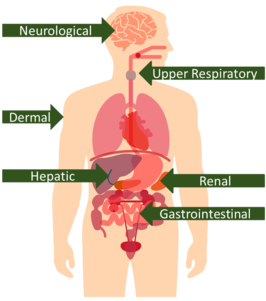

Generally, there are three types of cyanotoxins that some species of cyanobacteria can create, and they are grouped based on the acute effects they have on human and animal health:
Hepatotoxins are liver toxins and include microcystin and cylindrospermopsin. Microcystin is the most common cyanotoxin we hear about and observe in Wisconsin water bodies. Ingestion of hepatotoxins can result in gastrointestinal symptoms, such as vomiting and diarrhea, while more severe effects can include liver damage and liver failure. Cylindrospermopsin also targets and can damage the kidneys.
Neurotoxins we see in Wisconsin include anatoxin-a and saxitoxin. Ingestion of neurotoxins can have harmful effects on the central nervous system and can result in symptoms such as weakness, fatigue, and muscle twitching. Symptoms are more severe in animals and can include seizures and paralysis. Other neurotoxins in marine species of cyanobacteria are prominent in saltwater bodies and can cause symptoms similar to those of Paralytic Shellfish Poisoning, such as numb lips, tingling fingers and toes, and dizziness.
Dermatotoxin-like effects of cyanobacterial cell components, such as lipopolysaccharide endotoxin, can result in dermal symptoms, such as skin irritation or a rash, hives, or skin blisters, and may also contribute to gastrointestinal symptoms.
Depending on the route(s) of exposure, upper respiratory symptoms are also possible. If water droplets containing cyanotoxins are inhaled, a cough, throat irritation, or exacerbation of asthma symptoms may develop. Depending on the route(s) of exposure, cyanotoxins present at the time, and their concentrations, an individual may develop a combination of symptoms.
|
The background
Beta-N-methylamino-L-alanine, or BMAA, is a nonessential amino acid produced by most, if not all, species of cyanobacteria. BMAA has made recent news because of its suspected link to neurodegenerative diseases in humans and animals. The suspected link has been a hypothesis among some scientists since World War II, after U.S. forces recaptured the island of Guam. At the time, a Navy neurologist noticed signs of a neurodegenerative illness among island locals who consumed ground seeds from the cycad plant as well as small animals, such as bats, that fed on the seeds. Later, it was discovered that cyanobacteria-producing BMAA lived in the roots of the cycad and the coating of cycad seeds contained BMAA. Since then, this hypothesis has expanded to suggest that other cyanobacterial exposures, including seafood consumption and living on or in water bodies with prominent blooms, may also be linked to the incidence of neurodegenerative diseases in humans and animals with these exposures.
Is BMAA harmful to humans?
The short answer is that it’s unclear. In some, but not all, animal studies, BMAA was found to have neurotoxic effects. Since most data regarding the health effects of BMAA on humans come from case reports and not large-scale, controlled, epidemiologic studies, the study limitations are often significant. In 2017, the U.S. Environmental Protection Agency published a critical review that looked at the suspected role of BMAA in human neurodegenerative disease and concluded that the causal relationship was not supported by existing data.
Guidance for local and tribal health
No drinking or recreational water guidance levels currently exist for BMAA. Testing a water sample for BMAA is possible, but few laboratories have this capacity. Health and water resource officials at local and tribal agencies can use the following talking points about BMAA should they receive questions:
- BMAA is an amino acid made by most, if not all, cyanobacteria, which are photosynthetic bacteria that have been around for billions of years and are naturally found in all water bodies.
- BMAA and its suspected link to neurodegenerative disease has been a hypothesis since the 1940s and scientists have been working to investigate its effects on human and animal health for almost as long.
- The link between BMAA and neurodegenerative disorders in humans is uncertain. Even if a link does exist, contributing factors, such as how much BMAA a person is exposed to, how long they’re exposed for, and whether certain genetics make them more susceptible to neurodegenerative disease, remain unknown.
- To protect yourself, your family, and your pets from the harmful effects of cyanobacteria, don’t go in lakes, rivers, ponds, or the ocean if the water is discolored or where you see foam, scum, or algal mats. Cyanobacteria can create blooms that turn the color of the water to bright green, blue, purple, turquoise, white, or red. Always choose the clearest water possible to swim in and try to keep water out of your mouth. Besides cyanobacteria, surface water can contain other bacteria and parasites that can make you sick if you swallow it.
 Cycas micronesica, a cycad plant native to Guam. (Photo courtesy of the U.S. Fish and Wildlife Service and licensed under the Creative Commons Attribution-Share Alike 2.0 Generic license.)

Let's Get Social!
Did you know that not all cyanobacteria (also known as blue-green algae) are harmful? Of the more than 2,600 described species, only about 50 are known to produce toxins. Cyanobacteria have been around for billions of years and helped create the Earth’s oxygen-filled atmosphere as we know it today!
|

Stay in Touch
Missed a past issue? Previous issues are available on our Resources for Health Professionals webpage.
Email us your burning questions! If others can benefit from hearing the answer to your question, we’ll feature it in a future issue.
Remember that we are always available for consultation on any HAB health-related issue by email or phone (608-266-1120).
|
|